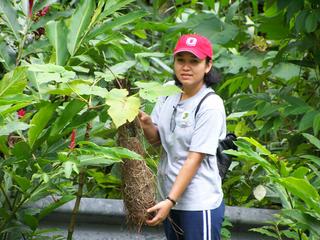Trip to the Rain Forest


During our first semester at the language school, all the students were taken on a field trip. (Beatriz is with fellow-student Melissa Goin of Washington). We visited a Rain Forest and learned some new things about ecology and Costa Rica. Although we didn't see many wild animals or birds on the trip, we did learn to appreciate a little more the beauty of God's creation.

One interesting fact is that many North American birds migrate to Costa Rica during our winter months. Beatriz is holding an unknown nest in this photo. It may be that of a Guacalchia, or it may be an Oriole or Weaver Bird. Whichever it is, it hangs its nest upside down from branches. We learned to appreciate the popular North American birds when we were living in various apartments in Boston and North Royalton, Ohio. One gets a little crazy just staring at walls in winter, so we bought bird feeders and began learning the names of the birds that visited us. Our Costa Rican guide showed us a book on Costa Rican birds and what really surprised us was that we were able to recognize many of the Costa Rican birds as North American birds too.

There are not only the tropical Parrots and Tucans (down below), but there are Sparrows, Finches and Grosbeaks; Tanagers (left), Warblers, and Wrens; Kingfishers and Cranes; Doves and Pigeons; American Orioles, Mockingbirds, Jays, tons of Hummingbirds and, what was most exciting to discover, Robins. Oh that unmistakeable song of the Robin.

We knew we recognized that familiar song in early May when the rainy season started. What a blessing. In fact, the national bird in Costa Rica is the Clay Colored Robin (above). It is called the Yigüirro here, but it hunts for insects and worms just like the American Robin (red-breast)does in Ohio. The blessing is that it reminds us a little of home.
We also learned that the Rain Forest is much different from our Forests in northern Ohio. Forests here are humid and damp and crawling with vines and other plants searching for the sun. Not many trees grow tall here, or straight, or old, because of the tropical climate and the competition they suffer from other plants. Heat, rain, insects, and a zillion other plants all compete for space and sun in the Rain Forest.

When a tree does grow tall, it usually has very few branches and most of them at the top. Once its branches grow above the forest, if it makes it that far, these tend to weigh the tree down so much that it becomes "top heavy." These kind of trees don't last very long. Indeed, very few trees in Costa Rica are old. It is even difficult to put a date on trees here because the rings on the inside do not mean what they do up north. In the U.S., the rings on trees represent the number of times a tree has passed between the seasons (winter and spring). Here, because there is no winter death, the trees do not have to grow new bark each year. It is an amazing thing.

We've been told that if the Rain Forests in Costa Rica were destroyed, the migrating species would have no place to live for the winter seasons. Things would be different in the north if things here would change for the worse. It makes one appreciate the wonder and wisdom of the Lord in creation.
